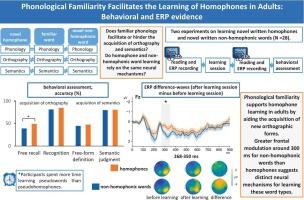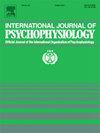语音熟悉有助于成人同音同义字的学习:行为和ERP证据
IF 2.6
3区 心理学
Q3 NEUROSCIENCES
引用次数: 0
摘要
同音异义词发音相同,但拼写和意义不同,给语言习得带来了挑战。本研究探讨了新同音同义词的语音熟悉是否有助于正字法形式和意义的学习,或者熟悉的声音和新正字法之间的不匹配是否会造成习得障碍。使用俄语单词,我们创造了与熟悉的单词发音相同但拼写不同的假同音词,以及在发音和拼写上与熟悉的单词不同的非同音假词。在两个实验中,28名参与者学习了假同音异义词和假单词。我们使用行为任务评估正字法和语义习得,并使用erp评估学习前后的神经反应。假同音异义词的学习速度较快,其正字法的习得也优于假词。在学习前,假词诱发的N400比熟悉词大,而假同音异义词诱发的N400差异不显著,这表明语音相似性阻碍了假词与真实词的区分。学习后,假词在P200、N250-P325和P600成分中出现了调制,反映了新的正字法表征、语音表征和语义表征的形成。相比之下,只有P600对假同音异义词进行了调制,可能是因为它们的音系已经很熟悉了。此外,假同音同义词和假词的对比显示,假词在300 ms左右时,由于学习过程,额叶区域的调制更大,这表明语音表征的形成和注意需求的增加。这些发现与连接主义双过程模型相一致,表明基于现有语音表征的假同音同义词具有学习优势。本文章由计算机程序翻译,如有差异,请以英文原文为准。

Phonological familiarity facilitates the learning of homophones in adults: Behavioral and ERP evidence
Homophones share identical pronunciations but differ in spelling and meaning, presenting a challenge in language acquisition. This study investigated whether the phonological familiarity of novel homophones aids the learning of orthographic forms and meanings or whether a mismatch between familiar sounds and new orthography creates obstacles to acquisition. Using Russian words, we created pseudohomophones that are identical in pronunciation to familiar words but have different spellings, as well as non-homophonic pseudowords that differ from familiar words in both pronunciation and spelling. Twenty-eight participants learned pseudohomophones and pseudowords in two experiments. We assessed orthographic and semantic acquisition using behavioral tasks and evaluated neural responses before and after learning using ERPs. Pseudohomophones were learned faster and their orthographic forms acquired better than those of pseudowords. Before learning, pseudowords elicited a larger N400 than familiar words, whereas pseudohomophones did not differ significantly, suggesting that phonological similarity hindered their distinction from real words. After learning, pseudowords showed modulations in the P200, N250-P325, and P600 components, reflecting the formation of new orthographic, phonological, and semantic representations. In contrast, only the P600 was modulated for pseudohomophones, likely because their phonology was already familiar. Moreover, comparison between pseudohomophones and pseudowords revealed greater modulation in frontal regions around 300 ms for pseudowords due to the learning session, indicating the formation of phonological representations and increased attentional demands. These findings are compatible with the connectionist dual-process model, suggesting a learning advantage for pseudohomophones based on existing phonological representations.
求助全文
通过发布文献求助,成功后即可免费获取论文全文。
去求助
来源期刊
CiteScore
5.40
自引率
10.00%
发文量
177
审稿时长
3-8 weeks
期刊介绍:
The International Journal of Psychophysiology is the official journal of the International Organization of Psychophysiology, and provides a respected forum for the publication of high quality original contributions on all aspects of psychophysiology. The journal is interdisciplinary and aims to integrate the neurosciences and behavioral sciences. Empirical, theoretical, and review articles are encouraged in the following areas:
• Cerebral psychophysiology: including functional brain mapping and neuroimaging with Event-Related Potentials (ERPs), Positron Emission Tomography (PET), Functional Magnetic Resonance Imaging (fMRI) and Electroencephalographic studies.
• Autonomic functions: including bilateral electrodermal activity, pupillometry and blood volume changes.
• Cardiovascular Psychophysiology:including studies of blood pressure, cardiac functioning and respiration.
• Somatic psychophysiology: including muscle activity, eye movements and eye blinks.

 求助内容:
求助内容: 应助结果提醒方式:
应助结果提醒方式:


